Albrecht Dürer - biography
Do you own a work by Albrecht Dürer, which you would like to sell?
Albrecht Dürer Prices
| Artist | Artwork | Price (incl. premium) |
|---|---|---|
| Albrecht Dürer | Young Woman Praying | €24.800 |
Albert Dürer was born in Nurnberg on 21 May 1471, the son of a goldsmith. From his seventeen siblings, only his brother Endres, who took over his father’s profession, and Hans, survived, who later rose to the position of court painter to the Polish king Sigismund I. Albrecht Dürer initially completed his studies as a goldsmith, but on discovering woodcut prints in the workshop of the Nurnberg artist Michael Wolgemut, his interest took a different path. The copperplate engravings of Martin Schongauer also had a great influence on the young artist. During his so-called Wanderjahre, Dürer earned his keep with drawings and woodcuts and became friends with the painter Hans Baldung Grien. After his return, he married Agnes Frey, the daughter of the esteemed businessman Hans Frey, who was a friend of his father. The marriage however remained childless and was not the happiest; in a letter to his close friend, the Humanist Willibald Pirckheimer, Dürer sometimes expressed himself extremely coarsely about his wife, whom he called the “old crow”. Agnes Dürer nevertheless played a great part in the economic success of her husband in dealing with the marketing of his artworks.
At a time when art was considered primarily a craft, Albrecht Dürer was one of the first to see himself as a creator of unique works. In order to emphasise his authorship, he designed his own iconic monogram, the large A over the D, which quickly gained wide recognition and found numerous imitators. Distinguishing himself not only as a painter and graphic artist, Dürer’s writings also attracted attention: in addition to art theoretical statements, he also wrote the first scientific mathematics book in the German language. He became world famous, however, with his efficacious religious pictures, whilst he earned well completing numerous commissions for King Maximilian I. The king was so impressed that he awarded Dürer with a life annuity of 100 gulden. He also achieved some fame as a portrait painter where, in contrast to the artistic conventions of the day, he placed particular value on the individuality of the persons portrayed.
Albrecht Dürer’s death on 6 April 1528 in his native city of Nurnberg is no more than a footnote, for the reception of his extensive oeuvre continued uninterrupted even after his death. His friend Williblad Pirckheimer already knew this when composing the headstone inscription: “That of Albrecht Dürer which was mortal, lies buried here”, he wrote in memory of his friend. To this day, engravings and paintings by Alrecht Dürer reach impressive heights; in the days of the German Mark, a Dürer could even pay for a Dürer. Four banknotes have carried motifs by Albrecht Dürer, and in 1971 he was honoured by the Deutsche Bundesbank with a memorial coin. The cult around this unique and productive artist remains unbroken and impels astonishing flowerings: Dürer is the subject of films and novels, his name adorns schools and a source, even immortalised as a Playmobil character, the specialist literature on his work is legion.
© Kunsthaus Lempertz
Do you own a work by Albrecht Dürer, which you would like to sell?
| Artist | Artwork | Price (incl. premium) |
|---|---|---|
| Albrecht Dürer | Young Woman Praying | €24.800 |
About Cookies
This website uses cookies. Those have two functions: On the one hand they are providing basic functionality for this website. On the other hand they allow us to improve our content for you by saving and analyzing anonymized user data. You can redraw your consent to using these cookies at any time. Find more information regarding cookies on our Data Protection Declaration and regarding us on the Imprint.
Settings
